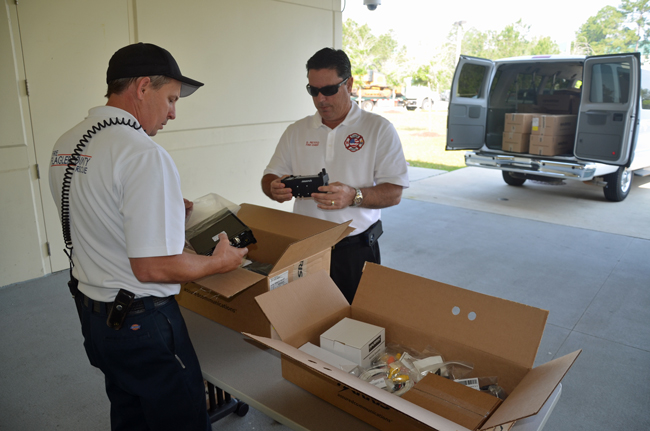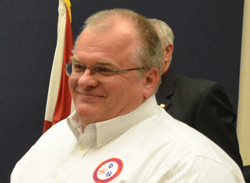
Old emergency radio systems never die. They just fade away. But that’s a potentially dangerous possibility for Flagler Conty’s police, fire and other public safety and public service agencies that rely on radio communications for emergency and routine operations. And the county’s radio system is approaching its “end of life.”
It’s less than eight years since Flagler spent $10 million to upgrade its county-wide communications to an 800 MHz system, to which some 1,500 radios are attached: the sheriff’s office, Bunnell and Flagler Beach’s police, every fire and rescue department in the county, all public works and public utility agencies: they’re all part of the system. The one notable exception is the school district, although there are 800 MHz radios at every school campus, enabling communications in emergencies.
But the whole system is reaching its expiration date in 2017. The county and the agencies that depend on the system must decide well before that time how they plan to upgrade or replace the system, who and how they will pay for it. It’ll be very expensive, just as the $10 million switch to the 800 MHz system was in 2005. But it can’t exactly be put off, even as the county is just beginning to take on two massive public expenses: the expansion of the county jail, and the reconstruction of the old Memorial Hospital into a sheriff’s office headquarters.
Monday afternoon, the county administration took the first step in the process as Kevin Guthrie, the county’s new public safety emergency manager, and Rolf Preuss, the 911 coordinator and radio systems manager, walked the county commission through the three options beginning to take shape. The two men spoke as a battery of industry vendors sat behind them, ogling the potential for cashing in on what will be a massive contract. County Administrator Craig Coffey warned the commissioners about the vendors.
“Vendors we have found even to this point have been very aggressive,” Coffey said. “They may reach out, try to contact you and lobby you or do whatever. We encourage you not to talk to these vendors at this point in the process because there’s a long road to go down and we’ve got a lot of work to do.” Coffey was echoing the same warning Palm Coast City Manager Jim Landon gave city council members when the city was re-examining its contract for trash pick-up: trash contractors are similarly aggressive.
The warnings are an indication of the breadth and pitfalls of the challenge commissioners face as they examine their communications system. Not only will they have to choose a reliable and cost-efficient system. But they will have to figure out what best option to adopt that will not too quickly become obsolete, or prove more expensive than it has to be, if they can delay some changes or take a more gradual approach. And that’s before figuring out how to pay for it, though Coffey is already suggesting that the current arrangement, which has the county bearing a large cost of the system’s backbone, may have to change, with Palm Coast, Flagler Beach and Bunnell assuming larger shares of the up-front and maintenance cost.
As for the county’s costs: those will be borne by revenue from the county’s sales tax supplement the county commission approved last year.

The county spent close to $10 million in 2005 to install the 800 MHz system, replacing a UHF and VHF system–$6.5 million for the backbone, and $3.25 million in front-end user agreement, such as radios.
By then, Volusia County had been on an 800 system for 10 years. In 2009, Palm Coast agreed to join the county’s system instead of alone shouldering the costs of expanding it (after installing its own system in 2004 for $1 million). The agreement required Palm Coast to set aside $300,000 a year for five years to cover future expansions of the system, in addition to a $217,000 charge to merge with the county. But the county was to provide the “backbone” of the system, such as assuming the costs of tower leasing and maintenance.
The system is not infallible: if the towers are knocked down, so is the system. But short of graduating to a prohibitively expensive satellite system, ground-based communications are the most workable solutions for now. Regardless: “It is going to be a costly upgrade over the next several years,” Coffey said.
Even though the county’s communications system will reach its official “end of life” in 2017, the system will still be usable just as it is now. The vendor will provide support for another three years. But it will do so only to the extent that parts are available. There is no guarantee that all such parts will be available. That’s the first option the county is considering: do nothing, and ride it out until 2020.
That’s not an approach the administration favors.
Since 2005, a new communications standard referred to as Project 25, or P25, has emerged. It is replacing the 800 MHz system. It is more nimble. “It’s a completely different system,” Preuss said. “It will also allow you to run the program on your iPad, on your Windows operating system, it’s basically a catch-all standard. The idea is once you have a system established like this, it does not matter what kind of radio you bring to the system, regardless of manufacturer.” (Volusia is moving in that direction.) Currently, Flagler’s system is not P25-compatible, but it is P25 capable. That means the existing system can lend itself to upgrades.
A second option is to run the current system until 2017 then replace it straight out with the P25 system. “That seems like a viable option, if you’re looking at timelines,” Preuss said.
“More expensive,” Coffey said.
A third option is to expand the existing system with a P25 enhancement, and little by little migrate the system from 800 to the P25. But at that point the two systems will not be capable of communicating with each other, unless the county comes up with a way to have them interface.
That’s the option that may be the most realistic, Preuss said. But it’s not as if commissioners must decide immediately.
“The whole reason for coming to you is to let you know that there’s an issue looming out there,” Guthrie said. “It is our thought process to form a team encompassing everybody who touches this system.” The team’s research will then be conveyed to commissioners as all options are examined before the most solid ones are recommended.
Money, of course, is a key concern.
“A computer used to cost $3,000 and now they’re $600. Is there any hope that these new systems are a third of the price of what we started at?” Commissioner Barbara Revels asked.
“Systems, honestly, no,” Preuss said. “The manufacturers want to be able to send out some pretty Christmas cards and have some Christmas dinners too. I’m feeling some knives in my back.” He was referring to the vendors sitting in the meeting room. But if the backbone of the system won’t come cheap, the radios will get cheaper, Preuss said. “The hybrid system can be run indefinitely or can be merged with a P25 system later.”




























Old Shep says
Use Morse code…Its cheaper !!!!
Anonymous says
Use what you have until you can afford something better!
Ogrethetop says
the county buys systems faster then I by cars. I think they need to wait till 2020 and figure it out then.
usn-ret says
… . _ _ . _ . _ _ . …. _ _ _ . _. . . _ _ _ _ _ _ . _ … . _ _ . . _ . . . _ . . . _ . _ . . . . . _ _ _
Kudos to the first person to decipher this.
confidential says
They always sell the BOCC a bill of lies and BOCC sock it to us.
fruitcake says
please explain to me again whats wrong with the current radios and system?
are they broken? are they going to vaporize in a year or two? They have to upgrade why?
The $10 million they spent isn’t good enough now? Are they not able to really function now?
There is a big difference between want and need…how about setting $1 million aside each year
until they have enough to pay for a new system when it’s really needed????
Anonymous says
It’s amazing how Troy left for another position and all of a sudden his replacement’s saying system is old a needs to be replaced. Wake up People!!! This is happening every day!
rich says
Why have our esteemed leaders not put a little bit away every year for this replacement? Lack of foresight or just laziness? And whose buddy is going to get this contract? Our new emergency director?